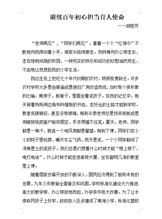初二英语冠词的知识点
冠词是虚词,本身不能单独使用,也没有词义,它用在名词的前面帮助指明名词的含义。冠词分为不定冠词a(an)和定冠词the两种。下面小阅给大家分享一些初二英语冠词的知识点,希望能够帮助大家,欢迎阅读!

初二英语冠词的知识1
不定冠词
We need an apple and a knife.
我们需要一个苹果和一把刀子。
1.a和an的区别
不定冠词有a[+]和an[+Q]两种形式,a用于辅音(不是辅音字母)开头的词前。an用于元音(不是元音字母)开头的词前。
a boy, a university, a European country
u是元音字母,但发音是[ju:],是辅音。
an hour ,an honor ,an island
h是辅音字母,但它不发音,它的音标是是元音。
an elephant, an umbrella, an egg
2(1)不定冠词的用法
①泛指—类人或物。
eg. This is a pencil case.
②指不具体的某个人或物。
eg. I met an old man On my way home.
③用在序数词前,相当于another.
eg. There’s a third boy near the shop.
④表示“每—(个)”,相当于every.
eg. They have music lessons twice a week.
必背!
give a lesson take a bath have a rest
教(一堂)课 洗(个)澡 休息
have a talk have a fever have a good time
听报告 发烧 过得愉快
have(take)a walk have a headache have a nice trip
散步 头疼 旅途愉快
a lot of, a lot, a little, a few, a glass of, such a/an, have a word with, have a look, have a try, have a swim, a quarter, half an hour, three times a day, have a talk, give a talk, ten Yuan a kilo
不定冠词的位置
①不定冠词—般放在所修饰的单数可数名词前。
eg, a bike, an egg
②当名词被such, what, many修饰时,不定冠词放在这些词之后。
eg.It took me half an hour to finish my homework.
He left in such a hurry that he forgot to close the door.
What a dangerous job it is!
Many a man has gone to the big cities for work.
③当名词前的形容词前有so, how, too等词时,不定冠词应放在形容词之后。
Eg. She was so nice a girl that she took the blind man to the station.
How nice a film this is!
④当名词前面有形容词和quite, rather, very时,不定冠词放在quite, rather之后,very之前。
eg.It is quite a good book.
That is rather a useful tool.
This is a very interesting story.
初二英语冠词的知识2
II.定冠词的用法
(1)定冠词的用法表示上文中所提到过的人或物。
eg:I have two children, a boy and a girl. The boy’s name is Mark. The girl’s name is Penny.
(2)特指某(些)人或物。
eg:The girl in a red dress comes from America.
(3)指说话人和听话人都熟悉的人或物。
eg: My shoes are under the bed.
Please open the window.
(4)用在形容最高级和部分比较级前,及形容词only, very, same等前面:
Eg: That's the very thing I've been looking for. 那正是我要找的东西。
Tom is the taller of the two boys.
He is the only person who didn't pass the exam.
他是唯一一个没通过考试的人。
(5)用在序数词前。
eg Monday is the second day of a week.
Where do you live? I live on the second floor.
(6)用在世界上独一无二的事物前(如太阳、月亮、世界、地球、天空、宇宙等)。
eg The moon moves round the earth.
(7)用在某些形容词前,表示—类人或物。
the rich(富人),the poor(穷人),the deaf(聋人),the blind(盲人),the dead(死者),the wounded(伤员)
(8)用在姓氏复数前,表示“某某—家人”或“某某夫妇”。
eg. The Greens are having dinner at home.
(9)用在乐器前。(但中国民族乐器前不用冠词,play Erhu拉二胡)
eg. play the piano/guitar/violin/drums.
(10)用于逢“十”的复数数词前,指某个世纪中的几十年代或人的大约年岁。
eg. In the 1970s, a highway was built to linkup the city with my hometown.
I think he is in the thirties.
(11)用在江河、海洋、山脉、湖泊、群岛的名称的前面。
the Yangzi River 长江
the North China Plain 华北平原
the Rocky Mountains 洛矶山脉
the Black Sea 黑海
(12)用在由普通名词和另外一些词构成的专有名词前面。
the Beijing Railway Station 北京站
the People's Republic of China 中华人民共和国
the United Nations 联合国
(13)含有定冠词the的词组。
in the morning (afternoon ,evening )在上午(下午、晚上)
on the right 在左边
by the way 顺便说一下
go to the cinema (theatre ,concert…)去看电影(看戏、听音乐会……)
in the front of 在前部
in the front of 在中间
at (in) the beginning 开始
in the end 终于
in the daytime 白天
on the one hand , on the other hand 一方面……;另一方面
注意:
表示某一类人或事物时,以下三种方法都可以。如:
The horse is a useful animal.(用定冠词)
A horse is a useful animal.(用不定冠词)
Horses are useful animals.(用复数)
马是一种有用的动物。
英语最实用的答题套路
1.英语听力
核心技巧:
1.后句比前句重要,回答比提问重要
2.若选项中个别单词或短语被明显播读,此项多为错项。同义词替换选项,正确可能性大。
3.同义词替换
4.关注英语对话潜在规则。
2.英语阅读
建议答题顺序:建议在听力完成后做,最多用时25分钟。我在课上多次强调
很多同学在阅读理解中,都错在了关键的第一步--审题上。
那么到底如何看题干,我们应该看哪里?
大部分同学知道,用时间,大写词去定位,但其实这只是最基本的定位信息。
3.审题
1.问谁的观点。常见四类观点:作者,大众,他人,研究报告
2.题干有没有特殊的副词或形容词。
3.定位尽量选两个词,回避全文核心词。
初二英语冠词的知识点相关文章:
★ 初二英语必备知识点:定冠词的常见用法
★ 初二英语知识点大总结
★ 初中英语冠词的语法归纳
★ 初二英语知识点总结
★ 初二英语知识点归纳
★ 初一英语语法的冠词知识点
★ 英语定冠词的知识点
★ 初二英语语法知识点
★ 初二英语语法重点知识点归纳





